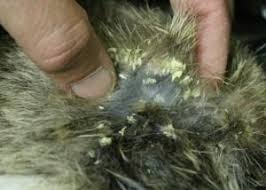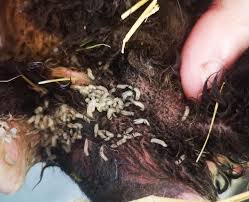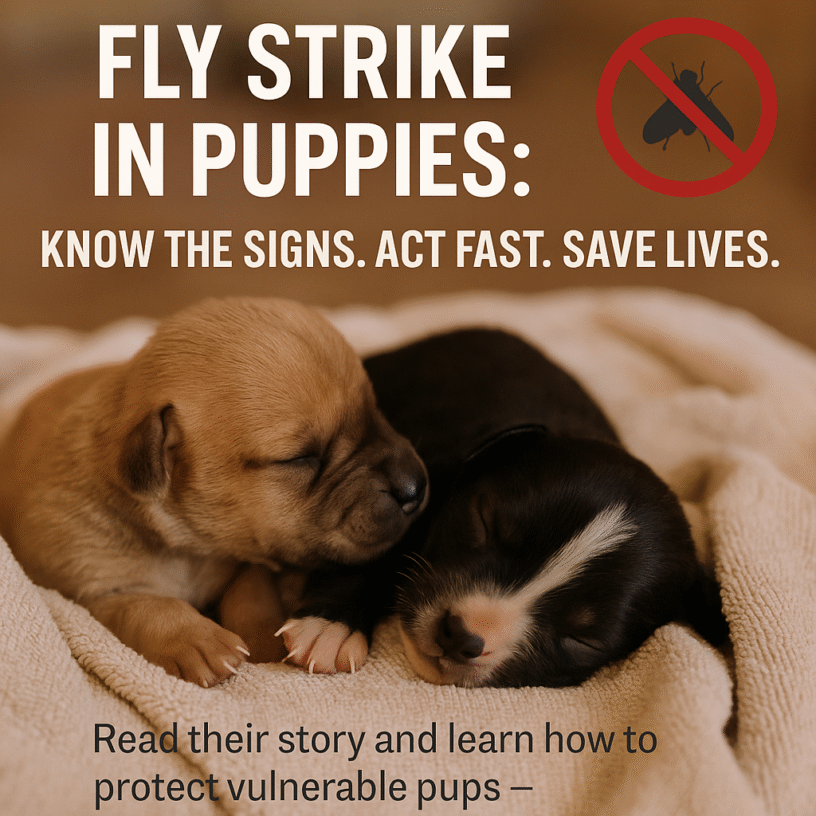They were only days old—eyes sealed shut, barely bigger than your palm. Born outside in a makeshift doghouse to a mother chained in the blazing summer heat, Sage and Scout never stood a chance. Their mother succumbed to heat exhaustion before help arrived. By the time the puppies were discovered, her body lay still beside them—and the flies had already begun to swarm. Eggs had been laid in their delicate skin. Tiny maggots were burrowing in, feeding off their fragile bodies. Tragically, despite every effort, Sage and Scout did not survive.
This is the devastating reality of fly strike in puppies. Fast-moving and gruesome, it demands swift action, knowledge, and prevention to save lives.
What Is Fly Strike (Myiasis)?
Fly strike, or myiasis, occurs when flies—usually blowflies—lay eggs on vulnerable areas of a puppy’s body. Within hours, the eggs hatch into maggots, which begin feeding on skin and tissue.
This isn’t just a matter of discomfort—it can lead to severe infection, tissue destruction, and death if not treated immediately.
Why Neonatal Puppies Are High Risk
Total Vulnerability
Newborns cannot move, groom, or vocalize distress effectively. This makes them an easy target for opportunistic flies.
Attractants: Moisture and Odor
Soiled bedding, unclean wounds, or diarrhea attract flies. Puppies in outdoor or unsanitary conditions are especially susceptible.
Rapid Egg Hatch Cycle
In summer temperatures, fly eggs can hatch in as little as 6–12 hours, turning minor issues into emergencies overnight.
What to Watch For: Early Signs of Fly Strike
The sooner fly strike is detected, the better the chances of survival. Common symptoms include:
- Clusters of small white eggs around the tail, umbilical area, ears, or wounds
- Visible maggots writhing in fur or skin
- Red, raw, or inflamed skin
- Foul-smelling discharge or necrosis
- Lethargy, crying, or refusal to nurse
Eggs are commonly laid in warm, moist areas—like near the umbilical cord, tail base, and between skin folds.


What to Do: Emergency Response Protocol
DO NOT Get the Area Wet
Moisture causes fly eggs to hatch more rapidly. Avoid bathing or rinsing the area with water before maggots are removed.
Step 1: Remove Visible Maggots and Eggs
Use a flea comb or tweezers to gently pull maggots from the skin. Work methodically and inspect every area.
Step 2: Use Capstar (Nitenpyram)
Capstar, an oral flea medication, also kills maggots. Crush a tablet, dissolve it in a small spray bottle with warm water, and apply topically to affected areas. Follow with oral administration for full effect (check dosage by weight).
Step 3: Clean the Area Safely
After maggot removal, flush the area with sterile saline. Do not use peroxide, alcohol, or oils. Avoid submerging the wound.
Step 4: Seek Immediate Veterinary Care
Puppies with fly strike need:
- Wound debridement
- Antibiotics and fluids
- Pain control
- Monitoring for shock or sepsis
Prevention: The Best Defense Against Fly Strike
Keep Puppies Indoors—Always
Even screened porches aren’t safe in fly season. Neonates must be kept in climate-controlled, sealed spaces.
Maintain Spotless Bedding
Change bedding multiple times a day. Sanitize surfaces and ensure all waste is immediately removed.
Monitor for Diarrhea or Wounds
Clean soiling immediately. Flies are drawn to moisture and odor.
Use Fly Barriers and Traps
Install fly tape and fans near puppy areas. Avoid strong chemical repellents in indoor spaces.
Deep Cleaning After Fly Strike
Once fly strike has occurred, decontamination is critical:
- Wash all fabrics in hot water and detergent
- Disinfect surfaces with Rescue™ cleaner or another veterinary-grade disinfectant
- Sterilize tools and combs between uses
- Dispose of infested materials safely
A Preventable Tragedy
Fly strike is horrifying—but it is also preventable. Indoor care, daily hygiene, and vigilant checks can stop this trauma before it begins.
Learn More: Related Puppy Health Topics
Want to understand more about protecting puppies from common health threats? Read next: The Puppy Parasite Playbook: Deworming, Diagnosis, and Survival

